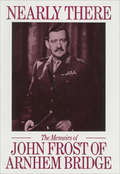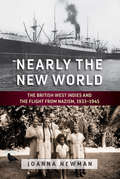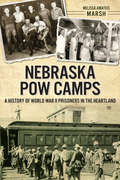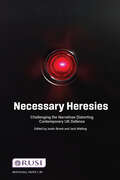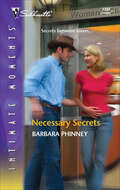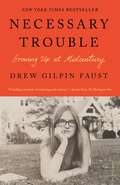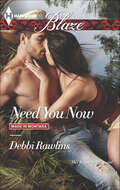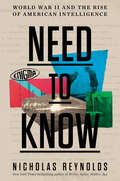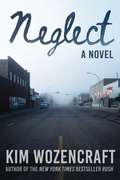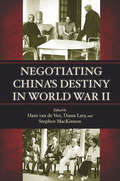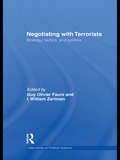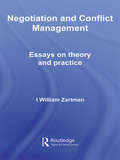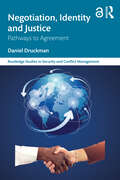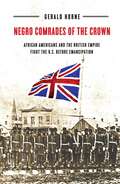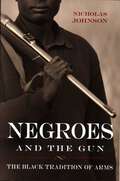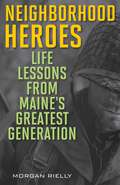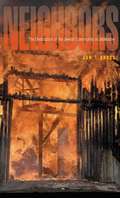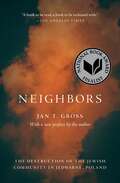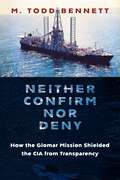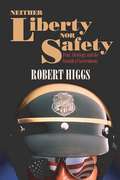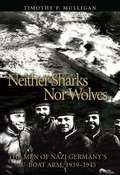- Table View
- List View
Nearly There: The Memoirs of John Frost of Arnhem Bridge
by Major General John FrostThis is the full autobiography of one of World War II's most popular heroes. Whilst Arnhem was the height of his career here he describes his early life in the Army (in Scotland), his service abroad, his polo matches, his family and, above all, the ever famous actions including the Bruneval Raid and the fighting in North Africa in which he took part.
Nearly the New World: The British West Indies and the Flight from Nazism, 1933–1945
by Joanna NewmanIn the years leading up to the Second World War, increasingly desperate European Jews looked to far-flung destinations such as Barbados, Trinidad, and Jamaica in search of refuge from the horrors of Hitler’s Europe. Nearly the New World tells the extraordinary story of Jewish refugees who overcame persecution and sought safety in the West Indies from the 1930s through the end of the war. At the same time, it gives an unsparing account of the xenophobia and bureaucratic infighting that nearly prevented their rescue—and that helped to seal the fate of countless other European Jews for whom escape was never an option.
Nebraska POW Camps: A History of World War II Prisoners in the Heartland
by Melissa Amateis MarshDuring World War II, thousands of Axis prisoners of war were held throughout Nebraska in base camps that included Fort Robinson, Camp Scottsbluff and Camp Atlanta. Many Nebraskans did not view the POWs as "evil Nazis." To them, they were ordinary men and very human. And while their stay was not entirely free from conflict, many former captives returned to the Cornhusker State to begin new lives after the cessation of hostilities. Drawing on first-person accounts from soldiers, former POWs and Nebraska residents, as well as archival research, Melissa Marsh delves into the neglected history of Nebraska's POW camps.
Necessary Heresies: Challenging the Narratives Distorting Contemporary UK Defence (Whitehall Papers)
by Justin Bronk Jack WatlingDominant narratives about the changing character of warfare and the revolutionary effect of technological advancement lack nuance and can ultimately be detrimental to the development of a defence capability fit for future purpose.
Necessary Secrets
by Barbara PhinneyWarrant Officer Sylvie Mitchell had resolved to put her last top secret military assignment behind her. Then Jon Cahill, her unborn baby's uncle, showed up, demanding answers about his brother's death in the line of fire. Answers that a government oath--and Sylvie's own guilt--wouldn't allow her to give...Jon was as determined to be her child's father figure as he was to learn about the fatal night Sylvie became pregnant. But despite the risk to her secrets, she soon found comfort in the sexy cop's passionate embraces. Would the one man who could chase away Sylvie's demons still want to be a part of her life when the painful truth was revealed?
Necessary Trouble: Growing Up at Midcentury
by Drew Gilpin FaustAN INSTANT NEW YORK TIMES BESTSELLERA memoir of coming of age in a conservative Southern family in postwar America.To grow up in the 1950s was to enter a world of polarized national alliances, nuclear threat, and destabilized social hierarchies. Two world wars and the depression that connected them had unleashed a torrent of expectations and dissatisfactions—not only in global affairs but in American society and Americans’ lives.A privileged white girl in conservative, segregated Virginia was expected to adopt a willful blindness to the inequities of race and the constraints of gender. For Drew Gilpin, the acceptance of both female subordination and racial hierarchy proved intolerable and galvanizing. Urged to become “well adjusted” and to fill the role of a poised young lady that her upbringing imposed, she found resistance was necessary for her survival. During the 1960s, through her love of learning and her active engagement in the civil rights, student, and antiwar movements, Drew forged a path of her own—one that would eventually lead her to become a historian of the very conflicts that were instrumental in shaping the world she grew up in.Culminating in the upheavals of 1968, Necessary Trouble captures a time of rapid change and fierce reaction in one young woman’s life, tracing the transformations and aftershocks that we continue to grapple with today.Includes black-and-white images
Need You Now (Made in Montana)
by Debbi RawlinsThe pastor's daughter...and the bad boy! Melanie Knowles is the Good Girl of Blackfoot Falls-pastor's daughter, teacher, animal shelter volunteer and upstanding member of the community. And Good Girls are never naughty. Ever. But Melanie is in serious trouble...because Lucas Sloan's wicked blue eyes and deliciously hard body could turn this saint into a very satisfied sinner! Lucas just wanted the Safe Haven animal shelter to help out with the Wild Horse Training Program. Getting hot for teacher was not part of the plan. The magnetism between them is intense, fierce and irresistible. But Lucas has secrets-and if Blackfoot Falls ever finds out, his sexy little trysts with the town sweetheart will ruin Melanie's golden reputation forever....
Need to Know: World War II and the Rise of American Intelligence
by Nicholas ReynoldsOne of The New Yorker's "Best Books of the Year" * A Gilder Lehrman Military History Prize Finalist"Authoritative. . . . [Reynolds's] contribution to our understanding of the rise of American intelligence is unparalleled." —Journal of Intelligence History“The most thorough and detailed history available on the origins of U.S. intelligence.” —Michael Morell, former Deputy Director and Acting Director, CIAHistorian and former CIA officer Nicholas Reynolds, the New York Times bestselling author of Writer, Sailor, Soldier, Spy, uncovers the definitive history of American intelligence during World War II, illuminating its key role in securing victory and its astonishing growth from practically nothing at the start of the war. The entire vast, modern American intelligence system—the amalgam of three-letter spy services of many stripes—can be traced back to the dire straits the world faced at the dawn of World War II. Prior to 1940, the United States had no organization to recruit spies and steal secrets or launch covert campaigns against enemies overseas and just a few codebreakers, isolated in windowless vaults. It was only through Winston Churchill’s determination to mobilize the US in the fight against Hitler that the first American spy service was born, built from scratch against the background of the Second World War.In Need to Know, Nicholas Reynolds explores the birth, infancy, and adolescence of modern American intelligence. In this first-ever look across the entirety of the war effort, Reynolds combines little-known history and gripping spy stories to analyze the origins of American codebreakers and spies as well as their contributions to Allied victory, revealing how they laid the foundation for the Cold War—and beyond.
Neglect: A Novel
by Kim WozencraftFrom the bestselling author of Rush comes a redemptive story of a young mother at war on two fronts. From bestselling author Kim Wozencraft comes the story of a young mother at war on two fronts: first as a soldier in Afghanistan and then upon her return to rural Granite County, New York, where one terrible mistake threatens her family and her sanity. Erin Hill enlists in the Army Reserve in an act of desperation. She and her husband have both lost their jobs and their marriage is disintegrating. Assured that the odds of deployment are extremely low, Erin now finds herself on an Army base in the middle of a combat zone, where it&’s sometimes hard to tell who the enemy is—especially when a respected sergeant turns predator. When Erin returns stateside and reunites with her family, her battle for survival truly begins. Flooded with traumatic memories, with no prospects for jobs or treatment for PTSD, her husband involved with a new woman, Erin falls into the bottle head-first. After a nearly fatal night of despair, she is swept up into a vast and indifferent bureaucracy that threatens to take her children from her—forever. Neglect is a profound story of mother love.
Negotiating China's Destiny in World War II
by Stephen R. Mackinnon Hans Van de Ven Diana LaryNegotiating China's Destiny explains how China developed from a country that hardly mattered internationally into the important world power it is today. Before World War II, China had suffered through five wars with European powers as well as American imperial policies resulting in economic, military, and political domination. This shifted dramatically during WWII, when alliances needed to be realigned, resulting in the evolution of China's relationships with the USSR, the U. S. , Britain, France, India, and Japan. Based on key historical archives, memoirs, and periodicals from across East Asia and the West, this book explains how China was able to become one of the Allies with a seat on the Security Council, thus changing the course of its future. Breaking with U. S. -centered analyses which stressed the incompetence of Chinese Nationalist diplomacy, Negotiating China's Destiny makes the first sustained use of the diaries of Chiang Kai-shek (which have only become available in the last few years) and who is revealed as instrumental in asserting China's claims at this pivotal point. Negotiating China's Destiny demonstrates that China's concerns were far broader than previously acknowledged and that despite the country's military weakness, it pursued its policy of enhancing its international stature, recovering control over borderlands it had lost to European imperialism in the nineteenth and early twentieth century, and becoming recognized as an important allied power with determination and success.
Negotiating Cultural Diversity in Afghanistan
by Omar SadrThis book analyses the problematique of governance and administration of cultural diversity within the modern state of Afghanistan and traces patterns of national integration. It explores state construction in twentieth-century Afghanistan and Afghan nationalism, and explains the shifts in the state’s policies and societal responses to different forms of governance of cultural diversity. The book problematizes liberalism, communitarianism, and multiculturalism as approaches to governance of diversity within the nation-state. It suggests that while the western models of multiculturalism have recognized the need to accommodate different cultures, they failed to engage with them through intercultural dialogue. It also elaborates the challenge of intra-group diversity and the problem of accommodating individual choice and freedom while recognising group rights and adoption of multiculturalism. The book develops an alternative approach through synthesising critical multiculturalism and interculturalism as a framework on a democratic and inclusive approach to governance of diversity. A major intervention in understanding a war-torn country through an insider account, this book will be of great interest to scholars and researchers of politics and international relations, especially those concerned with multiculturalism, state-building, nationalism, and liberalism, as well as those in cultural studies, history, Afghanistan studies, South Asian studies, Middle East studies, minority studies, and to policymakers.
Negotiating with Terrorists: Strategy, Tactics, and Politics (Political Violence)
by I. William Zartman Guy Olivier FaureThis edited volume addresses the important issue of negotiating with terrorists, and offers recommendations for best practice and processes. Hostage negotiation is the process of trying to align two often completely polarised parties. Authorities view hostage taking as unacceptable demands made by unacceptable means. However terrorists view their actions as completely justified, even on moral and religious grounds. If they are to try and reconcile these two sides, it is essential for hostage negotiators to understand terrorist culture, the hostage takers’ profiles, their personality, their view of the world and also the authorities, their values and their framing of the problem raised by the taking of hostages. Although not advocating negotiating with terrorists, the volume seeks to analyse when, why, and how it is done. Part I deals with the theory and quantifiable data produced from analysis of hostage situations, while Part II explores several high profile case studies and the lessons that can be learnt from them. This volume will be of great interest to students of terrorism studies, conflict management, negotiation, security studies and IR in general. I William Zartman is the Jacob Blaustein Distinguished Professor Emeritus of International Organization and Conflict Resolution and former Director of the Conflict Management and African Studies Programs, at the Paul H. Nitze School of Advanced International Studies, Johns Hopkins University, Washington, DC. He is a member of the Steering Committee of the Processes of International Negotiation (PIN) Program at the International Institute of Applied Systems Analysis (IIASA) in Laxenburg, Austria. He is author/editor of over 20 books on negotiation, conflict and mediation. Guy Olivier Faure is Professor of Sociology at the Sorbonne University, Paris I, and a member of the Steering Committee of the Processes of International Negotiation (PIN) Program at the International Institute of Applied Systems Analysis (IIASA) in Laxenburg, Austria. He has served as an advisor to French government on hostage negotiations.
Negotiation and Conflict Management: Essays on Theory and Practice (Routledge Studies in Security and Conflict Management #Vol. 1)
by I. William ZartmanThis book presents a series of essays by I. William Zartman outlining the evolution of the key concepts required for the study of negotiation and conflict management, such as formula, ripeness, pre-negotiation, mediation, power, process, intractability, escalation, and order. Responding to a lack of useful conceptualization for the analysis of international negotiation, Zartman has developed an analytical framework and specific concepts that can serve as a basis for both study and practice. Negotiation is analyzed as a process, and is linked to other major themes in political science such as decision, structure, justice and order. This analysis is then applied to negotiations to manage particular types of conflicts and cooperation, including ethnic conflicts, civil wars and regime-building. It also develops typologies and strategies of mediation, dealing with such aspects as leverage, bias, interest, and roles. Written by the leading exponent of negotiation and mediation, Negotiation and Conflict Management will be of great interest to all students of negotiation, mediation and conflict studies in general.
Negotiation in International Conflict: Understanding Persuasion (The Sandhurst Conference Series #No. 4)
by Deborah Goodwin Matthew MidlaneThis work explores the application and structure of negotiation within existing international conflicts, and assesses the effectiveness, or otherwise, of such forms of dispute resolution. It examines the role of negotiation and the skills required by any practitioner in the field.
Negotiation, Identity and Justice: Pathways to Agreement (Routledge Studies in Security and Conflict Management)
by Daniel DruckmanThis volume presents contributions made by Daniel Druckman on the topics of negotiation, national identity, and justice.Containing research conducted and published over a half century, the volume is divided into seven thematic parts that cover: the multifaceted career, flexibility in negotiation, values and interests, turning points, national identity, and process and outcome justice. It rounds off with a reflective and forward-looking conclusion. Each part is prefaced with an introduction that highlights the chapters to follow.The chapters comprise empirical, theoretical, and state-of-the-art articles. These essays offer an array of research approaches, which include experiments, simulations, and case studies, with topics ranging from boundary roles and turning points in negotiation to nationalism and war, and the way that research is used in skills training for diplomats and in the development of government policies. In addition, the book provides rare glimpses of behind-the-scenes networks, sponsors, and events, with personal stories that also make evident that there is more to a career than what appears in print. The articles chosen for inclusion are a small set of the total number of career publications by the author but are the ones that made a substantial impact in their respective fields. The concluding section looks back at how the author’s career connects to classical ideas and the value of an evidence-based approach to scholarship and practice. It also looks forward to directions for future research in six areas.This book will be of considerable interest to students of international negotiation, conflict resolution, security studies, and international relations.Chapter 16 of this book is freely available as a downloadable Open Access PDF at http://www.taylorfrancis.com under a Creative Commons Attribution-Non Commercial-No Derivatives (CC-BY-NC-ND) 4.0 license.
Negro Comrades of the Crown: African Americans and the British Empire Fight the U.S. Before Emancipation
by Gerald HorneWhile it is well known that more Africans fought on behalf of the British than with the successful patriots of the American Revolution, Gerald Horne reveals in his latest work of historical recovery that after 1776, Africans and African-Americans continued to collaborate with Great Britain against the United States in battles big and small until the Civil War. Many African Americans viewed Britain, an early advocate of abolitionism and emancipator of its own slaves, as a powerful ally in their resistance to slavery in the Americas. This allegiance was far-reaching, from the Caribbean to outposts in North America to Canada. In turn, the British welcomed and actively recruited both fugitive and free African Americans, arming them and employing them in military engagements throughout the Atlantic World, as the British sought to maintain a foothold in the Americas following the Revolution. In this path-breaking book, Horne rewrites the history of slave resistance by placing it for the first time in the context of military and diplomatic wrangling between Britain and the United States. Painstakingly researched and full of revelations, Negro Comrades of the Crown is among the first book-length studies to highlight the Atlantic origins of the Civil War, and the active role played by African Americans within these external factors that led to it. Listen to a one hour special with Dr. Gerald Horne on the "Sojourner Truth" radio show.
Negroes and the Gun: The Black Tradition of Arms
by Nicholas JohnsonChronicling the underappreciated black tradition of bearing arms for self-defense, this book presents an array of examples reaching back to the pre-Civil War era that demonstrate a willingness of African American men and women to use firearms when necessary to defend their families and communities. From Frederick Douglass's advice to keep "a good revolver" handy as defense against slave catchers to the armed self-protection of Monroe, North Carolina, blacks against the KKK chronicled in Robert Williams's Negroes with Guns, it is clear that owning firearms was commonplace in the black community. NicholasJohnson points out that this story has been submerged because it is hard to reconcile with the dominant narrative of nonviolence during the civil rights era. His book, however, resolves that tension by showing how the black tradition of arms maintained and demanded a critical distinction between private self-defense and political violence. Johnson also addresses the unavoidable issue of young black men with guns and the toll that gun violence takes on many in the inner city. He shows how complicated this issue is by highlighting the surprising diversity of views on gun ownership in the black community. In fact, recent Supreme Court affirmations of the right to bear arms resulted from cases led by black plaintiffs. Surprising and informative, this well-researched book strips away many stock assumptions of conventional wisdom on the issue of guns and the black freedom struggle.
Neighborhood Heroes: Life Lessons from Maine's Greatest Generation
by Morgan RiellyInspired by the old African proverb: "When an old man dies, a library burns to the ground," high-school student Morgan Reilly sought to preserve as many Maine libraries as he could by interviewing men and women from Maine who served in World War II and preserving their stories. All of these veterans taught him something, too, not just about how to fight a war, but how to live a life. They were never preachy, never full of themselves. Each of them knew they had participated in something great and special, but none of them thought that they, themselves, were great or special. There was Fred Collins, the sixteen-year-old Marine who used his Boy Scout training to clip a wounded soldier's chest together using safety pins from machine gun bandoliers while under withering fire on Iwo Jima. Or Inex Louise Roney, who served as a gunnery instructor for the Marines, hoping she could end the war sooner and bring her brother home. Or Harold Lewis, who held onto hope despite being shot down out of the sky, nearly free-falling to his death, and spending four months behind enemy lines in Italy. Or jean Marc Desjardins, whose near-death experiences defusing German bombs with his buddy Puddinghead, taught Reilly the value of a good friend.
Neighbors: The Destruction of the Jewish Community in Jedwabne, Poland
by Jan T. GrossOne summer day in 1941, half of the Polish town of Jedwabne murdered the other half, 1,600 men, women, and children, all but seven of the town's Jews. Neighbors tells their story. This is a shocking, brutal story that has never before been told. It is the most important study of Polish-Jewish relations to be published in decades and should become a classic of Holocaust literature. Jan Gross pieces together eyewitness accounts and other evidence into an engulfing reconstruction of the horrific July day remembered well by locals but forgotten by history. His investigation reads like a detective story, and its unfolding yields wider truths about Jewish-Polish relations, the Holocaust, and human responses to occupation and totalitarianism. It is a story of surprises: The newly occupying German army did not compel the massacre, and Jedwabne's Jews and Christians had previously enjoyed cordial relations. After the war, the nearby family who saved Jedwabne's surviving Jews was derided and driven from the area. The single Jew offered mercy by the town declined it. Most arresting is the sinking realization that Jedwabne's Jews were clubbed, drowned, gutted, and burned not by faceless Nazis, but by people whose features and names they knew well: their former schoolmates and those who sold them food, bought their milk, and chatted with them in the street. As much as such a question can ever be answered, Neighbors tells us why. In many ways, this is a simple book. It is easy to read in a single sitting, and hard not to. But its simplicity is deceptive. Gross's new and persuasive answers to vexed questions rewrite the history of twentieth-century Poland. This book proves, finally, that the fates of Poles and Jews during World War II can be comprehended only together.
Neighbors: The Destruction of the Jewish Community in Jedwabne, Poland
by Jan T. GrossA landmark book that changed the story of Poland’s role in the HolocaustOn July 10, 1941, in Nazi-occupied Poland, half of the town of Jedwabne brutally murdered the other half: 1,600 men, women, and children—all but seven of the town’s Jews. In this shocking and compelling classic of Holocaust history, Jan Gross reveals how Jedwabne’s Jews were murdered not by faceless Nazis but by people who knew them well—their non-Jewish Polish neighbors. A previously untold story of the complicity of non-Germans in the extermination of the Jews, Neighbors shows how people victimized by the Nazis could at the same time victimize their Jewish fellow citizens. In a new preface, Gross reflects on the book’s explosive international impact and the backlash it continues to provoke from right-wing Polish nationalists who still deny their ancestors’ role in the destruction of the Jews.
Neiman-Marcus, Texas: The Story of the Proud Dallas Store
by Frank X. TolbertHerbert Marcus, Sr., a former buyer with Dallas’ Sanger Brothers department store, had left his previous job to found a new business with his sister Carrie Marcus Neiman and her husband, A.L. Neiman, then employees of Sanger Brothers competitor A. Harris and Co. In 1907 the trio had $25,000 from the successful sales-promotion firm they had built in Atlanta, Georgia, and two potential investments into which to invest the funds. Rather than take a chance on an unknown “sugary soda pop business,” the three entrepreneurs rejected the fledgling Coca-Cola company and chose instead to return to Dallas to found a retail business. The store, established on September 10, 1907, was lavishly furnished and stocked with clothing of a quality not commonly found in Texas. Within a few weeks, the store’s initial inventory, mostly acquired on a buying trip to New York made by Carrie, was completely sold out. Oil-rich Texans, welcoming the opportunity to flaunt their wealth in more sophisticated fashion than was previously possible, flocked to the new store. In spite of the Panic of 1907 set off only a few weeks after its opening, Neiman Marcus was instantly successful, and its first several years of operation were quite profitable.Neiman-Marcus, Texas by Frank X. Tolbert “tells the story of Dallas’ fashion-wise emporium, from its start in 1907 to its acclaim today [1953], and is profiled here in all its elegance, community significance and individual enterprise.”
Neither Confirm nor Deny: How the Glomar Mission Shielded the CIA from Transparency (Global America)
by Professor Todd BennettIn 1974, the Hughes Glomar Explorer, ostensibly an advanced deep-sea mining vessel owned by reclusive billionaire Howard Hughes, lowered a claw-like contraption to the floor of the Pacific Ocean. This high-tech venture was only a cover story for an even more improbable scheme: a CIA mission to retrieve a sunken Soviet submarine. Like a Jules Verne novel with an Ian Fleming twist, the saga of the Glomar Explorer features underwater espionage, impossible gadgetry, and high-stakes international drama. It also marks a key moment in the history of transparency—and not just for what became known as the Glomar response: “We can neither confirm nor deny. . . . ”M. Todd Bennett plumbs the depths of government secrecy in this new account of the Glomar mission and its consequences. Trawling through recently declassified documents, he explores the logistics, media fallout, and geopolitical significance of one of the most ambitious operations in intelligence history. Glomar, Bennett argues, played a pivotal but underappreciated role in helping the CIA ward off oversight amid a push for transparency and accountability. He reframes the operation’s history to offer an alternative perspective on the 1970s, a decade known for expansive openness, as well as the persistent tension between the demands of democracy and the need for secrecy in foreign policy. Combining keen historical analysis and gripping storytelling, Neither Confirm nor Deny brings to the surface fresh insights into the history of the security state, the politics of intelligence, and the CIA’s relationship with the media and the public.
Neither Liberty nor Safety: Fear, Ideology, and the Growth of Government
by Robert Higgs"Those who would give up essential Liberty, to purchase a little temporary Safety, deserve neither Liberty nor Safety," wrote Benjamin Franklin. Attempting to gain security by sacrificing liberty is also a foolish action because it only increases the potential for harm.In Neither Liberty Nor Safety: Fear, Ideology, and the Growth of Government, economist and historian Robert Higgs illustrates the false trade-off between freedom and security by showing how the U.S. government&’s economic and military interventions reduced the civil and economic liberties, prosperity, and genuine security of Americans in the 20th century. Extending the theme of Higgs&’s earlier books, Neither Liberty Nor Safety stresses the role of misguided ideas in the expansion of government power at the expense of individual liberty. Higgs illuminates not only many underappreciated aspects of the Great Depression, the two world wars, and the postwar era, but also the government&’s manipulation of public opinion and the role that ideologies play in influencing political outcomes and economic performance.
Neither Sharks Nor Wolves
by Timothy MulliganA character study of the German submarine force that challenges traditional and revisionist views of the service.
Neither War Nor Peace: The Struggle for Power in the Postwar World
by Hugh Seton-WatsonExploring the rivalry between the United States and the Soviet Union.
